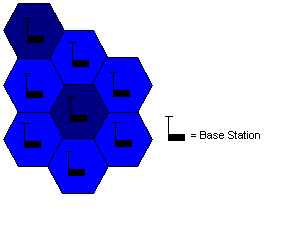
The dark blue cells represents the base stations that use the same frequencies. Since base stations use low-power transmitters, base stations can use the same frequencies if they aren't not to each other.
The cell phone is basically a very complicated radio. For cell phones to work cities are divided into "cells". A city has 800 different frequencies to use. The frequencies are divided among the cells in the shape of hexagons about the size of 10 square miles. In the center of these cells is a base station which send and receives signals from phones within the 10 mile range. Base stations use low-power transmitters so base stations can use the same frequency in a city as long as they are not adjacent to each other. Each city has one Mobile Telephone Switching Office which connects cell phones to normal phones.
When actually calling someone the phone checks the reception then sends a registration request to to the MTSO to verify your location. When it receives your location it connects to a base station that is responsible for the cell you are in. Then it sends a signal to the number you dialed, checks what cell that number is it and connects.
During these processes identities are also being sent. These ids are basically phone numbers. Phone number indicates what area you are in and what provider you are using.